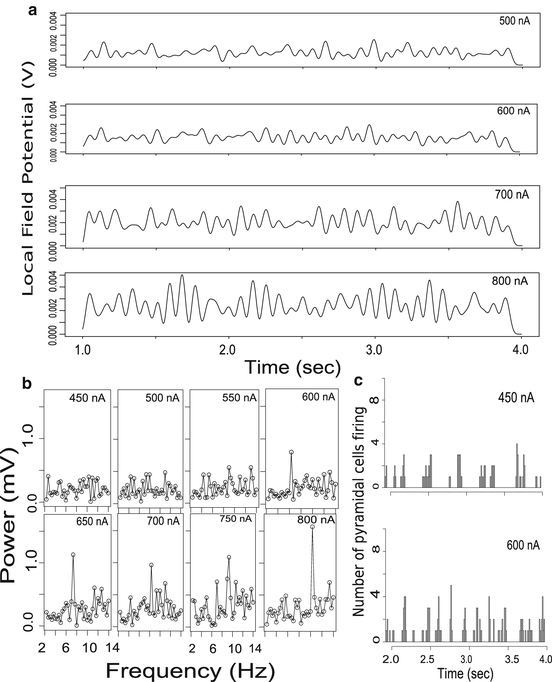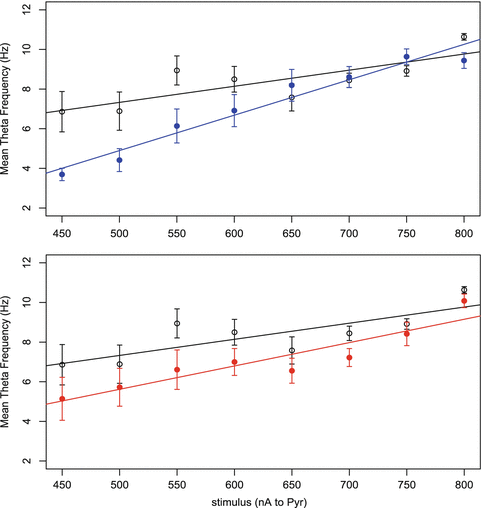Fig. 1
Structure of septo-hippocampal network model. Three hippocampal neuron populations and one medial septal population are modeled explicitly. Two medial septal populations are modeled indirectly by their rhythmic or tonic effects on the system (squares). Red symbols and black circles indicate inhibitory populations and synapses, respectively; yellow symbols and open triangles indicate excitatory populations and synapses
Septo-hippocampal theta rhythm was recorded as a population activity measured as the extracellular field potential around pyramidal cells, the most abundant neurons in the relevant neural tissue. The mean theta-range frequency of the LFP was determined as the frequency corresponding to the peak of the power spectrum in the range 2–12 Hz. The time-dependence of synaptic conductances was modeled as following first-order kinetics according to the equation
 with s representing the fraction of open synaptic channels at the post-synaptic membrane, weighted by a maximal conductance g syn to evaluate post-synaptic current. The multiplicative inverse of the β term in this synaptic model is referred to as the decay time constant of the post-synaptic current, τ syn [5].
with s representing the fraction of open synaptic channels at the post-synaptic membrane, weighted by a maximal conductance g syn to evaluate post-synaptic current. The multiplicative inverse of the β term in this synaptic model is referred to as the decay time constant of the post-synaptic current, τ syn [5].

See this webpage for the R, Octave, and GENESIS code used to generate the simulation experiments and data analysis: http://geza.kzoo.edu/theta/thetaFreq.html. ANCOVA followed by Tukey contrasts was used to compare the intercepts of nPO stimulation elicited theta frequency-stimulus relationships before and after potential anxiolytic effects were applied.
3 Results
The LFP generated by pyramidal neurons exhibited increasing frequency and amplitude of oscillation in the 3–10 Hz theta range (Fig. 2a). The frequency of synchronous firing amongst pyramidal cells also increased with increased nPO stimulation (Fig. 2c). An approximately linear increase in mean theta frequency with nPO stimulus level was observed (Fig. 3; black).


Fig. 2
(a) Synthetic LFP recordings from pyramidal cells for increasing nPO stimulation in model. (b) Representative power spectra of LFP in the theta band for increasing nPO stimulation. (c) Representative firing histograms showing increasing frequency of synchronous firing in pyramidal somata
The decay time constant of all GABA-receptor mediated synapses was doubled to test the effect on elicited theta frequency. A significant interaction effect between nPO stimulus level and decay time constant of GABA synapses was observed ( , Fig. 3) suggesting an increased slope of the stimulus-frequency relationship when the time constant was doubled. The intercept of the regression line was also significantly reduced (
, Fig. 3) suggesting an increased slope of the stimulus-frequency relationship when the time constant was doubled. The intercept of the regression line was also significantly reduced ( ) when the decay time constant was doubled.
) when the decay time constant was doubled.
 , Fig. 3) suggesting an increased slope of the stimulus-frequency relationship when the time constant was doubled. The intercept of the regression line was also significantly reduced (
, Fig. 3) suggesting an increased slope of the stimulus-frequency relationship when the time constant was doubled. The intercept of the regression line was also significantly reduced ( ) when the decay time constant was doubled.
) when the decay time constant was doubled.








